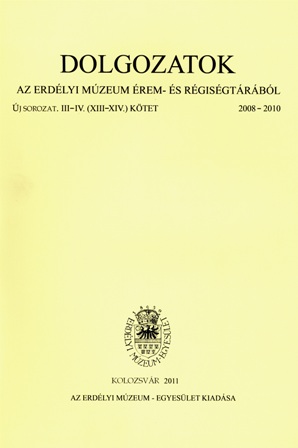Egy dáciai vámhivatalnok családi síremléke
The Familial Funerary Monument of a Dacian Customs Officer
A Newly Discovered Funerary Altar in Porolissum
Author(s): Dávid Petruţ, Cristian Găzdac, Szilamér-Péter Pánczel, István Bajusz, Ágnes Găzdac-Alföldy, Silvia Mustaţă, Lóránt VassSubject(s): History, Archaeology, Cultural history, Economic history, Social history, Ancient World
Published by: Erdélyi Múzeum-Egyesület
Keywords: Dacia; customs officer; funeral monument; funerary altar; Porolissum
Summary/Abstract: Due to the Necropolis Porolissensis Project, beginning with the year 2006, systematic archaeological research has been undertaken in the Roman cemetery of Porolissum (Dacia Porolissensis), known as the necropolis from the “Ursoieși Hill”. During the excavations from 2008, on a 10x10 m surface (Trench J) 19 cremation graves were discovered together with fragments belonging to various funerary monuments. Amongst them, we discovered a funerary altar with truncated pyramid coping. The body of the altar was found collapsed near the rectangular stone masonry foundation. Its frontal side, containing the two panels of inscription and decoration, was exfoliated and broken in 3 larger fragments. The separated coping was found next to it. From the typological point of view, the monument belongs to the category of funerary altars with profiled framing on the body, while the coping belongs to the type known as: “truncated pyramid shaped coping with straight sides”. It is worth mentioning that this is the only pyramid shaped coping with straight edges discovered, at the moment, in the province of Dacia, all the other examples belong to the variant with curved sides. The epitaph is displayed in two panels: the main one on the shaft of the altar contains the names of the deceased (one name is still preserved), while the second panel of inscription, placed on the base of the monument (in a tabula ansata) contains the name, social position and job of the person who erected and dedicated the monument. Owing to the fact that the surface of the altar is heavily damaged the inscription is only partially readable. Still, after detailed investigations we managed to retrieve some information on one of the deceased, as well as on the dedicator. According to the inscription’s text, one of the deceased bares the name of Cleopatra and her death occurred at the age of 7 years. No other information was available from the main inscription field. However, following the calculations on the inscription panel and letters’ size we can assume the presence of other 2, maybe 3, more names amongst the deceased peoples to whom the monument was erected and dedicated. From the text on the second panel (the tabula ansata), we find out, that the dedicator was named Martinus, and that he was a slave working for the customs office of the town – ver(na) et vil(icus). Considering, that the name of the father is not mentioned next to that of the deceased (as it normally should) we presume a parental relationship between the two. On the base of archaeological and stylistic criteria (the flat relief), the monument can be dated in the 2nd century, a more precise dating could not be obtained.
Journal: Dolgozatok az Erdélyi Múzeum Érem- és Régiségtárából. Új sorozat
- Issue Year: 2010
- Issue No: III-V
- Page Range: 55-61
- Page Count: 7
- Language: Hungarian

